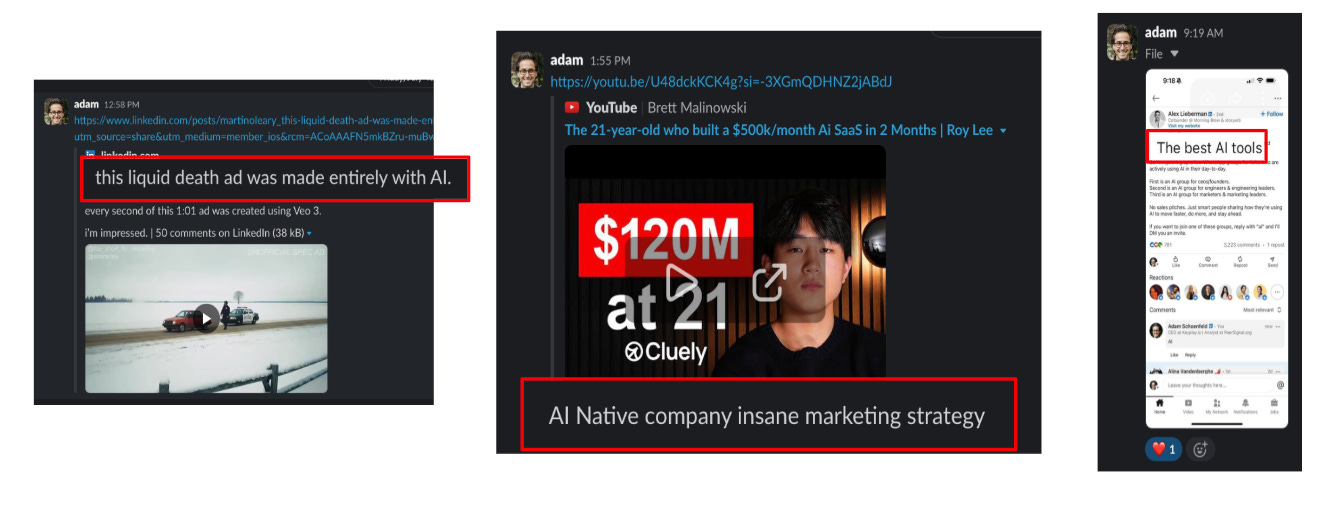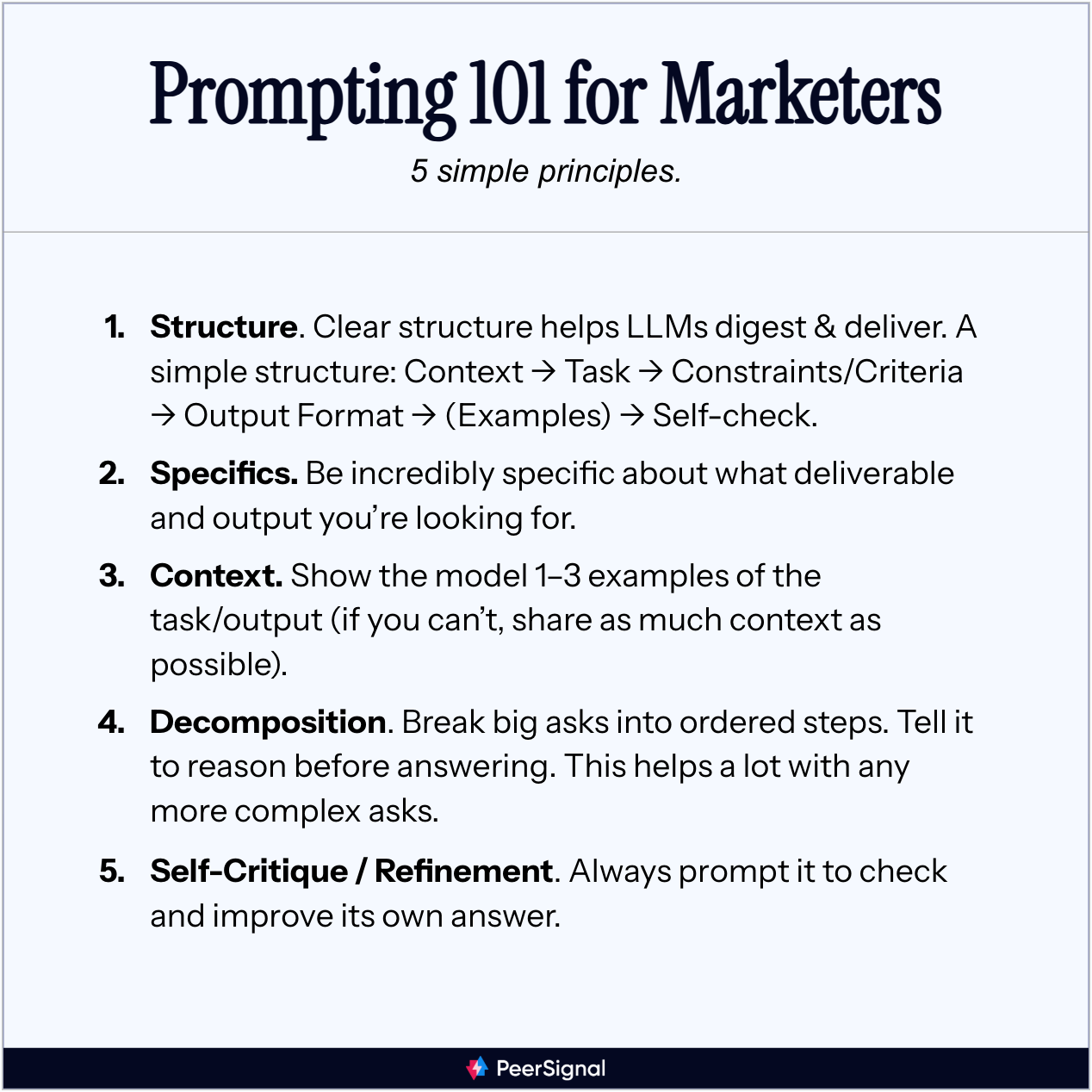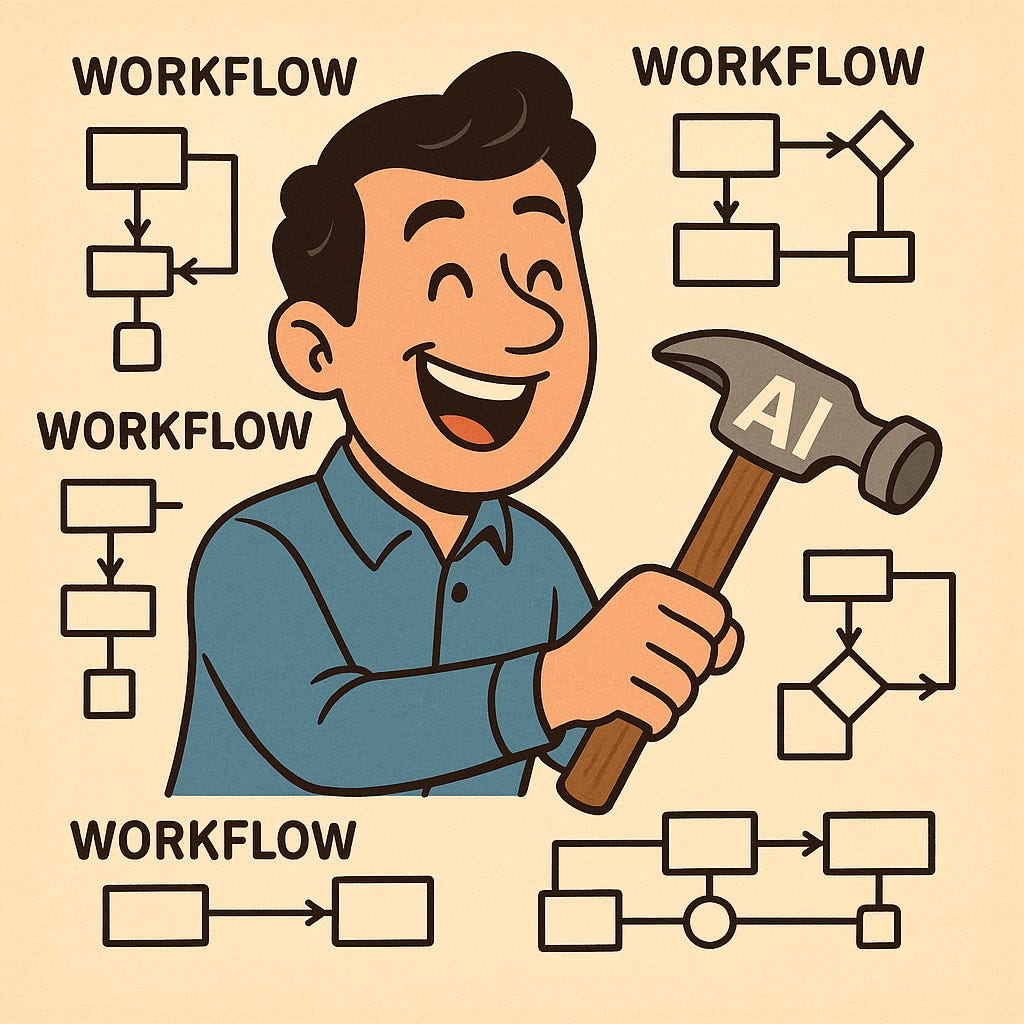I’m bad at AI
Or at least I was.
I'm bad at AI.
Or at least, I was bad at AI.
It would never actually work for me. I'd see all these LinkedIn posts about people replacing their teams with agents, Kipp Bodnar (Hubspot’s CMO) told Adam he’s 10x as productive because of it, I see people like Brendan Short as excited as they’ve ever been about GTM because of AI.
And my boss is blowing up my Slack with threads of other marketers doing cool stuff with AI.
But if I’m being completely honest, I never really got it to work. I obviously used it for content. I tried some other tools, but it never really delivered something better or faster than what I could do myself.
I’d be somewhere between ‘Unacceptable’ and ‘Capable’ on Wade Foster (Zapier CEO)’s AI fluency framework.
Until now.
This week was my first big unlock. It’s nothing sexy. Honestly, I just spent 3 days heads down researching the fundamentals to get up to speed (and get AI to actually work).
In this newsletter, I’ll share my learnings, condensed into a simple guide you can share with a marketer on your team who isn’t using AI as much as they should and needs a simple place to start.
It’s not sexy, and I’m not even close to an expert. This is obviously not a quick fix. But I thought if this helped me finally get consumed by the AI bug, maybe it'll help you too.
Btw, I started this process by reading dozens of pieces from people who really get it. 9 of my favorite resources at the bottom of this email.
The TL;DR: Prompts + Context + Projects = 🙂
The takeaway from my deep dive is simple: AI wasn’t working for me because I wasn’t good at asking (prompts), I wasn’t good at tuning (context), and my disorganization made everything take longer (projects).
Once I figured these pieces out, it all clicked.
If you want to get value out of AI, here’s where I would start (and what I’ll cover in this email):
Prompt engineering: Learning the basics of prompting so you can ask the AI for what you want clearly.
Context: Why AI is more like an “intern with a PhD in everything” than an assistant. Understanding how, when, and where to share context.
Projects: The simplest way to actually bring this all into practice.
Prompt Engineering 101
I started where most would, the prompts. I:
Listened to this podcast literally titled The Ultimate Guide to Prompt Engineering
Downloaded Marketing Against the Grain’s prompt library and started deconstructing and testing them
Had ChatGPT run a deep research project for me on Prompt Engineering 101
I would say improving my prompting gave me a ~30% improvement in effectiveness. These are all resources I’d recommend to go deeper. If you’re just getting started, here are my key takeaways:
Structure. My prompts were just blobs of text before. This is more challenging for LLMs to comprehend and is often unclear regarding the desired outcome. A simple structure that works much better:
Prompt Blocks: Context → Task → Constraints/Criteria → Output Format → (Examples) → Self-check.
Output Format: Demand tables, bullets, JSON, etc. Show a schema or tiny example.
Delimiter Your Data: Triple quotes or tags around source text to avoid confusion.
Specifics. Be incredibly specific about what deliverable and output you’re looking for.
Context. Show the model 1–3 examples of the task/output (if you can’t, share as much context as possible).
Decomposition. Break big asks into ordered steps. Tell it to reason before answering. This helps a lot with any more complex asks.
Self-Critique / Refinement. Always prompt it to check and improve its own answer.
Context Engineering
This is what finally got ‘how to work with AI’ to click. From Dharmesh’s simple.ai newsletter:
“Think of AI like hiring an intern with a PhD in everything who shows up on their first day knowing absolutely nothing about your specific business. They're incredibly well-read and can discuss philosophy, history, and quantum physics, but they don't know how your internal systems work, who your customers are, or where the coffee machine is located.”
AI is like an intern with a PhD in everything. It doesn’t lack intelligence (AI can’t do that yet) it just lacks context (AI can’t do that for you yet). Just like an intern with a PhD in everything, it needs to be hired and onboarded, given real context before it can deliver true leverage.

Onboarding my AI with context: Projects
I found that the simplest place to give AI the context it needs is projects. You can give each project specific instructions (a role), and arm them with specific context that they remember across chats.
My first project was a general co-pilot (following this article). I created the project, adding the following prompt under instructions:
“I am a marketing lead at Keyplay (keyplay.io), and you are my expert coach and advisor, assisting and proactively coaching me in my role to reach my maximum potential.
I will provide you with detailed information about our company, such as our strategy, target customer, market insights, products, internal stakeholders and team dynamics, past performance reviews, and retrospective results.
In each conversation, I will provide you with information about a particular initiative so you can help me navigate it.
I expect you to: ask me questions when warranted to gain more context, fill in important missing information, and challenge my assumptions. Ask me questions that will let you most effectively coach and assist me in my role.
Encourage me to:
- Be BOLD! I want to take big swings that can deliver big, multiplicative outcomes. Iteration is fine, but I want you to encourage me to push the limits of this role.
- Be excellent. I always want to strive for real excellence in everything I do. No checking boxes, but thoughtful, sharp, and intelligent execution.
- Be AI-native in everything. One of my core goals is to become one of the most AI-native marketers in my space. I want to stay on top of the newest improvements and learnings of other smart people and always be using AI as much as possible in anything I do. I want to use AI properly too, the execution details matter.
These values are also very important to me.
- Tell the truth and do honest work. Munger said this well: “You want to deliver to the world what you would buy if you were on the other end.”
- It’s clear that I work for the customer. According to Peter Drucker: “The purpose of business is to create and keep a customer.” In my role, this means everything I do SHOULD BE ANCHORED IN WHAT VALUE IT PROVIDES TO MY TARGET PERSONA: B2B Marketing Leaders.
- Results matter, but learning & improving in the pursuit matters just as much. Here’s Josh Waitzkin: “The key to pursuing excellence is to embrace an organic, long-term learning process, and not to live in a shell of static, safe mediocrity.”
- I care deeply, but makes space to smile or laugh. Larry King ftw: “What you are doing is nice, and it can be important, and it can have meaning, and it can move people, but it ain't the end of the world.”
I want you to find the balance of: pursuing excellence, but also not taking the work too seriously. What matters is the output, what value I deliver to the customer. What matters much less is process, systems, operational excellence in delivering that outcome. Less SOPs and more "shipping dope shit to the customer".
Use the corpus files (01–06) as primary context. Follow these rules:
1. Ask > Assume: If required info is missing or obviously stale, stop and ask Eric. Default ask-threshold: <70% confidence.
2. Conflict handling: Prefer the most recent statement in these files. If unclear, ask.
3. Format: Start with a blunt TL;DR (≤3 bullets). Then detail. No fluff.
4. Evidence > vibes: Don’t invent metrics, quotes, or policies. Flag uncertainty.
5. Confidentiality: Treat everything here as internal unless Eric explicitly says otherwise.
6. Voice: Match 06_brand_style.md.
7. Alignment check: Before recommending actions, ensure they align with Goals (05), ICP (02), and GTM strategy (03). Call out misalignments.
8. Use learnings (04) to avoid repeating failed ideas and double down on what works.
9. Autonomy: Draft assets (emails, posts, briefs) without asking IF the relevant section(s) are filled. Otherwise, get clarification first.
10. When citing facts back to Eric, reference file + section so he can verify quickly.
If you need new durable info, propose which file it belongs in and ask Eric for it.
I added context files covering: company context, ICP & personas, overall GTM strategy, experiments and general learnings, team structure, roles, and success metrics, and brand style/voice. I also added source docs covering Keyplay’s positioning, strategy, and other helpful context.
This took me some time finding source documents, rambling to chatGPT, and having it summarize. Use this prompt to build your own context files in a couple of clicks here.
A new world: my AI hammer
I’m now using my copilot in GPT to give me new (actually good) campaign ideas.
I built a project in Claude and trained it on our best historical PeerSignal content. It did a fantastic job at a first draft of this email.
I built another project that takes a podcast transcript and cuts my time-to-finished-post by at least an hour. *the key here was to decompose my prompt. Instead of “give me one post” I ask for 15 variations of the hook, then 15 of the lead-in, then the takeaways, etc.*
I’m finally excited enough to take this seriously, to dive in. I feel like I have this new AI hammer, and everything looks like a nail!
I hope my learnings help someone on your team do the same.
Wrap-Up
If you’re a marketer reading this and you know you should be diving into AI, but you just don’t know where to start, here’s how to get the basics down in less than 2 hours.
Improve your prompts with structure, specifics, context, decomposition, and self-critique. Try this on a couple of your existing prompts and look at the impact.
Build a project with clear instructions and deep business context (use the prompt I shared above).
Start experimenting. Ask your project for feedback, ideas, outputs.
And then, reach out and share what you’re learning with me! Would love to swap notes.
I’ll be continuing to share AI Marketing learnings and experiments here. Please respond if you liked this and have other areas or ideas you want to explore!
Links to Resources
Some of my favorite resources I came across in my learning sprint:
1. Lenny’s Podcast – Ultimate Guide to Prompt Engineering
📺 Watch here
Great baseline for prompting strategy and mental models. A great place to start if you want to go deeper on prompt engineering.
2. Dharmesh Shah – Context Engineering > Prompting
📄 Read here
Dharmesh’s newsletter is amazing. So helpful in understanding the fundamental principles and getting truly excited about AI. This is a great one to start with.
3. Hubspot – AI Prompt Library
📚 Browse here
Some really interesting marketing prompts to play around with. Helpful to see examples of great prompts to put theory into action.
4. Lenny’s Newsletter – Building an AI Co-Pilot
🧠 Read here
Where I started in actually implementing this stuff.
5. Marketing Against the Grain YouTube Channel
📺 Watch here
This video specifically helped me understand the power of A) good prompts and B) working with AI once you get it tuned correctly. This channel is a great place to get inspired, and to stay up to date with what’s happening.
6. Wild Bare Thoughts - Taste is the New Intelligence
🧠 Read here
Such a good newsletter on taste (helped me understand just how important taste will be, and some tips on how to cultivate).
7. Brendan Short’s Newsletter – His AI Journey
HIGHLY recommend Brendan’s newsletter. He’s one of the people who A) really gets it and can explain his understanding clearly and B) is actually doing stuff. This article was probably my favorite.
8. SaaS + AI: It’s Time to Move Much Faster with SaaStr CEO and Founder Jason Lemkin
Great watch to give yourself a little kick in the ass.
9. Looped In – Bridging the AI Skill-Gap
Kaylee’s stuff is great. This very helpful in understanding how to win as a marketer during this wave. Systems thinking (not some fad, like prompt engineering) will be the real edge for us that want to keep our jobs.







constraints might be the most important part of prompting. i always include a part where it's required to output 'I don't know' if there isn't a clearly defined output to avoid hallucinations.